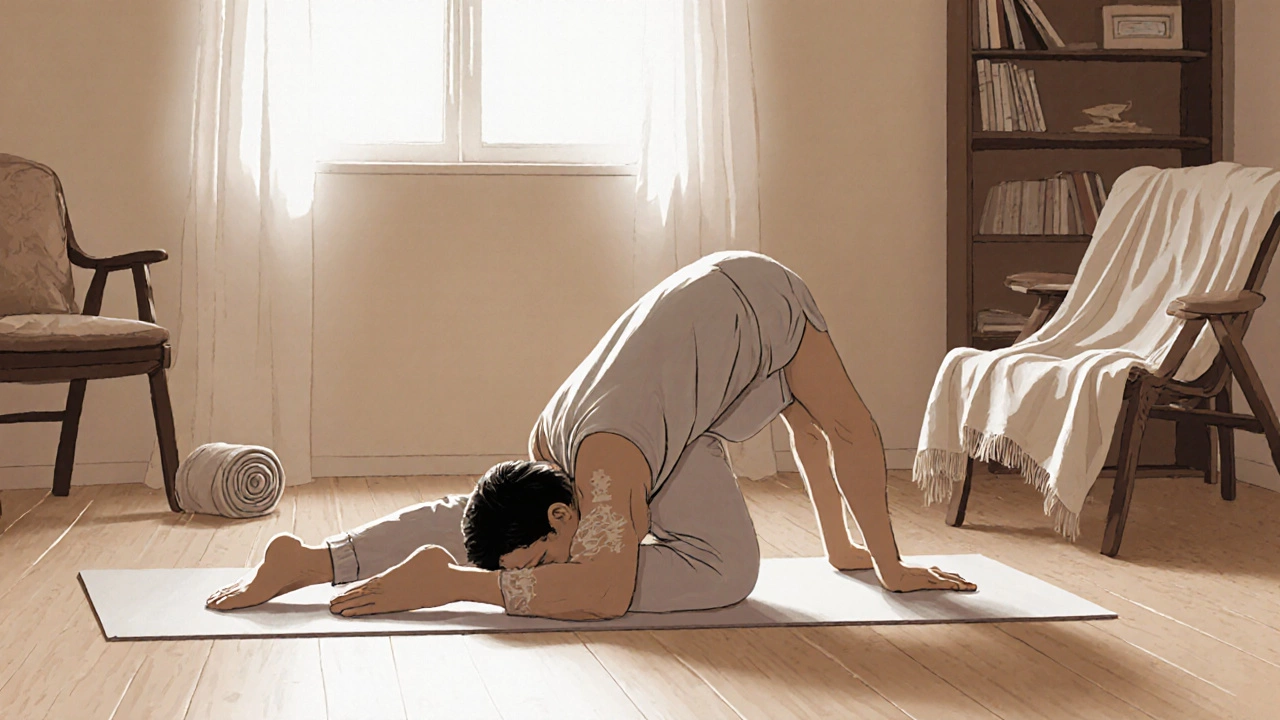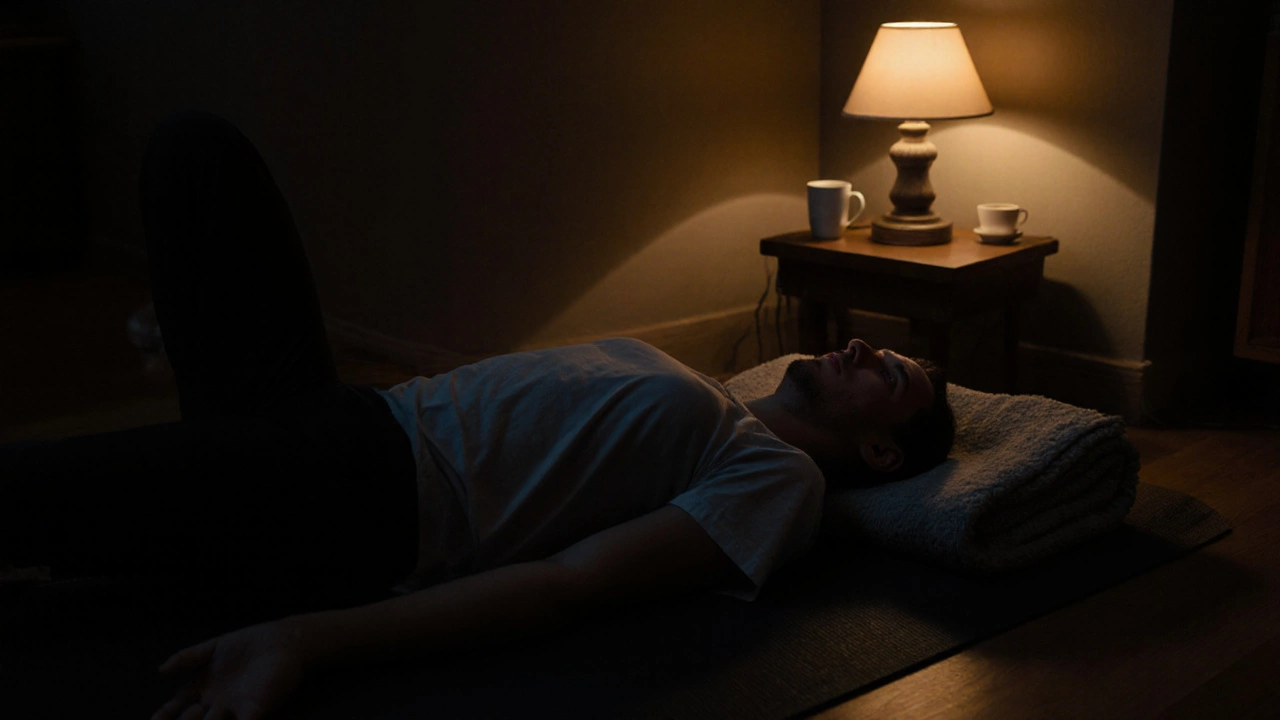How to Start Yoga for Beginners: A Simple Guide to Begin Today

Yoga doesn’t require a fancy studio, expensive gear, or flexible limbs. You just need a quiet corner, a mat, and the willingness to show up. If you’ve ever watched someone fold into a pose like it’s nothing and thought, ‘I could never do that’-you’re not alone. Most people start yoga thinking they need to be bendy. The truth? Yoga starts where you are, not where you think you should be.
What Yoga Actually Does for Beginners
Yoga isn’t just stretching. It’s a system that connects breath, movement, and awareness. For beginners, the biggest benefits show up in ways you might not expect: less tension in your shoulders, better sleep, fewer morning aches, and a calmer mind after a long day. A 2023 study from the University of Calgary’s Human Performance Lab found that people who practiced yoga just three times a week for eight weeks reported a 37% drop in stress-related headaches and improved focus at work.
You don’t need to touch your toes to get these results. You just need to breathe through a few simple poses and stick with it.
Step 1: Get the Bare Essentials
You don’t need much to start. Here’s what you actually need:
- A yoga mat (non-slip, at least 4mm thick)
- Comfortable clothes that let you move (no jeans, no tight waistbands)
- A quiet space (a corner of your bedroom, living room, or even your garage)
- A timer or phone (to track 10-15 minute sessions)
That’s it. No blocks, straps, or candles required. Skip the fancy gear until you know you’ll stick with it. Many beginners buy $100 mats and never use them. A $20 mat from a local store works just fine.
Step 2: Start with 10 Minutes a Day
Trying to do an hour-long class on day one is a fast way to quit. Start small. Ten minutes a day, five days a week, is enough to build a habit.
Here’s a simple 10-minute routine you can do right now:
- Seated Breathing (2 minutes) - Sit on the floor or a chair, back straight, hands on knees. Close your eyes. Breathe in through your nose for four counts, hold for two, breathe out for six. Repeat.
- Cat-Cow Stretch (2 minutes) - On all fours, inhale as you drop your belly and lift your head (cow), exhale as you round your spine and tuck your chin (cat). Move slowly with your breath.
- Child’s Pose (2 minutes) - Knees wide, big toes touching, forehead on the floor. Arms stretched out or resting by your sides. Breathe deeply.
- Standing Forward Fold (2 minutes) - Stand with feet hip-width apart. Bend at your hips, let your head hang. Bend your knees as much as you need to. Let gravity do the work.
- Final Relaxation (2 minutes) - Lie on your back, arms at your sides, palms up. Close your eyes. Don’t fix anything. Just breathe.
Do this every morning or right before bed. No pressure to get it perfect. If you only make it through three poses? That’s still progress.
Step 3: Choose the Right Type of Yoga
Not all yoga is the same. There are dozens of styles, but for beginners, stick to these three:
- Hatha Yoga - Slow-paced, focused on basic poses and breathing. Best for total beginners.
- Yin Yoga - Long holds (3-5 minutes per pose), great for releasing deep tension. Ideal if you sit all day.
- Restorative Yoga - Uses props to support your body in relaxing poses. Perfect if you’re tired, stressed, or recovering from injury.
Avoid Vinyasa, Ashtanga, or Power Yoga until you’ve built strength and familiarity. These are fast-paced and can lead to injury if you’re not ready.

Step 4: Find a Good Online Class (or Local Studio)
YouTube is full of yoga videos-but not all are beginner-friendly. Look for classes labeled “beginner,” “gentle,” or “foundations.” Avoid instructors who say things like, “If you can’t do this, you’re doing it wrong.” That’s not yoga. That’s performance.
Try these free, well-reviewed options:
- Yoga with Adriene - Her “30 Days of Yoga” series is perfect for first-timers. She’s calm, clear, and never pushes.
- Boho Beautiful Yoga - Beautiful settings, gentle pacing. Great if you like nature backdrops.
- DoYogaWithMe.com - Filter by “beginner” and “10-20 minutes.” No sign-up needed.
If you prefer in-person classes, look for studios that offer “intro to yoga” or “beginner series.” Many studios in Calgary, like The Yoga Room or Namaste Yoga, offer first classes for $5 or free. Don’t be afraid to ask: “Is this class okay for someone who’s never done yoga?” Good teachers will say yes.
Step 5: Watch Out for These Beginner Mistakes
Most people quit yoga not because it’s hard-but because they do it wrong at first. Here’s what to avoid:
- Pushing into pain - Discomfort is normal. Sharp pain is not. Back off if you feel it.
- Comparing yourself to others - Your neighbor’s hamstrings aren’t your problem. Focus on your breath, not their pose.
- Skipping breath - If you’re holding your breath, you’re not doing yoga. Breath is the anchor.
- Doing it only when you “feel like it” - Consistency beats intensity. Five minutes daily beats one hour once a week.
One of my students, a 58-year-old teacher from Calgary, started yoga after back surgery. She did 7 minutes a day for six months. Now she walks without pain and sleeps through the night. She never did a single advanced pose. She just showed up.
What to Expect in the First 30 Days
Don’t expect to flip into a handstand. But here’s what you will notice:
- By day 7: You breathe deeper when you’re stressed.
- By day 14: Your neck and shoulders feel looser.
- By day 21: You catch yourself pausing before reacting to frustration.
- By day 30: You look forward to your 10 minutes. It’s no longer a chore-it’s your reset button.
These changes are real. They’re measurable. And they’re not magic. They’re the result of showing up, even when you don’t feel like it.

When to Move Beyond Beginner Yoga
You’ll know you’re ready to level up when:
- You can hold a 5-minute plank without shaking
- You’re comfortable breathing through discomfort (not pain)
- You can follow a 30-minute class without needing to stop
- You start craving more movement, not less
Then try a gentle Vinyasa class or a yoga flow with light resistance. But even then-keep your breath as your guide.
Final Thought: Yoga Isn’t About Perfection
Yoga isn’t about how far you can stretch. It’s about how present you can be. Some days your body will feel strong. Other days, you’ll barely make it through the first pose. That’s okay. That’s the practice.
You don’t need to be flexible. You don’t need to be quiet. You don’t need to wear leggings. You just need to show up-on the mat, on the floor, in your own skin-and breathe.
Can I do yoga if I’m not flexible?
Yes, absolutely. Yoga isn’t about flexibility-it’s about building awareness and strength over time. Most beginners start stiff. That’s why yoga exists. The poses adapt to your body, not the other way around.
How often should a beginner do yoga?
Three to five times a week is ideal, but even two sessions a week will bring benefits. Consistency matters more than duration. Ten minutes daily beats an hour once a week.
Do I need to buy special yoga clothes?
No. Sweatpants, t-shirts, or even pajamas work fine as long as they let you move freely. Avoid anything too loose that might slip during poses. Comfort is the only requirement.
Is yoga good for back pain?
Yes, when done gently. Yoga helps strengthen the core and release tension in the spine. Poses like Cat-Cow, Child’s Pose, and Supine Twist are especially helpful. Always avoid deep forward bends or twists if you have acute pain-consult a physiotherapist first.
Can I do yoga at home without equipment?
Yes. A towel or carpet works as a mat. A pillow or rolled-up blanket can replace a yoga block. A chair helps with balance. You don’t need gear to start-just space and intention.
What’s the best time of day to do yoga?
Morning is great for energy, evening is best for relaxation. The best time is the one you’ll actually do. Pick a time that fits your schedule and stick with it.
Next Steps: Your First 7 Days Plan
Here’s a simple roadmap to build your habit:
- Day 1 - Do the 10-minute routine above. Just once. No pressure.
- Day 2 - Repeat. Notice how your body feels after.
- Day 3 - Watch one 10-minute YouTube class (Yoga with Adriene’s Day 1).
- Day 4 - Try the routine again, but breathe slower.
- Day 5 - Do it in the morning and again before bed.
- Day 6 - Skip the poses. Just sit and breathe for 5 minutes.
- Day 7 - Reflect: Did you feel calmer? Less stiff? More present? That’s yoga.
You don’t need to be good at yoga. You just need to keep showing up. The rest will follow.

